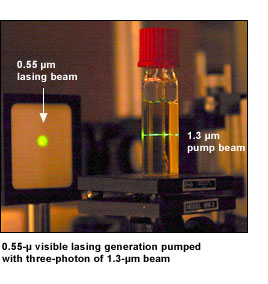BUFFALO, N.Y., March 14 -- The first observation of a phenomenon called stimulated emission by direct three-photon excitation, which occurs when three photons of lower energy are simultaneously absorbed to reach a higher energy state, has been reported by a team of  University at Buffalo researchers in the current issue of Nature.
Applications of the phenomenon could lead to technological advances including sharper pictures on computer monitors, higher-quality long-distance telephone lines, more stable optical fiber networks and the ability to visualize and destroy deep tumors with light.
University at Buffalo researchers in the current issue of Nature.
Applications of the phenomenon could lead to technological advances including sharper pictures on computer monitors, higher-quality long-distance telephone lines, more stable optical fiber networks and the ability to visualize and destroy deep tumors with light.
The team from UB's Institute for Lasers, Photonics and Biophotonics was the first to demonstrate in 1996 organic materials capable of efficiently absorbing two photons of light at the same time and their applications, especially in high-density data storage.
This latest observation demonstrates the remarkable three-photon simultaneous absorption efficiency of an organic dye, APSS ((4-[N-(2-hydroxyethyl)-N-methyl) amino phenyl]-4'-(6-hydroxyhexyl sulfonyl)stilbene) synthesized by the UB scientists to produce stimulated emission, a property that creates laser light.
The work also demonstrates an important phenomenon, three-photon pumped frequency upconversion, in which fluorescent emissions are produced with higher energy than the laser's pumping photon, a process called upconversion.
"This is a breakthrough for demonstrating that highly efficient, three-photon absorbing materials can be produced that can act as a medium for upconversion lasing," said Paras Prasad, Ph.D., executive director of UB's Institute for Lasers, Photonics and Biophotonics and co-author on the paper.
The research demonstrates for the first time the highly efficient, simultaneous absorption of three photons of light in an organic material pumped by a wavelength of laser light at 1.3 micrometers, one of only two frequencies suitable for critical applications in optical fiber telecommunications.
For applications from long-distance telephone communications to much clearer teleconferencing over the Internet, this three-photon process can potentially be used to improve the quality of transmission.
By achieving three-photon activation of the organic dye at a wavelength of 1.3 micrometers, the team was able to shift this infrared wavelength (invisible color) into the visible range, appearing as a green-yellow light. This visible light will be useful for applications in optical imaging, bioimaging, diagnostics and photodynamic therapy of deep tissue tumors.
Because the nature of three photon absorption is highly nonlinear (output is not directly proportional to input), it also provides an efficient mechanism useful for applications in optical power limiting, which helps prevent damage from power surges, and in stabilizing power fluctuations to reduce noise.
"We have taken light at the communications wavelength in the infrared range and by pumping it with our three photon process have shown that our system produces very localized, efficient emissions in the visible range," Prasad said.
In principle, according to Guang S. He, Ph.D., lead author on the paper and senior research scientist at the UB Institute for Lasers, Photonics and Biophotonics, the upconversion properties of multiphoton absorption may also lead to the possibility of generating ultrashort-wavelength UV lasers in suitable materials. Such lasers would be useful in applications ranging from laser weapons systems to semiconductor processing.
"Shorter wavelengths also are desirable for many applications in data transmission," explained He, "because they allow for higher density data storage and higher resolution of that data."
The work was supported by the U.S. Air Force Office of Scientific Research and the polymer branch of the U.S. Air Force Research Laboratory at Dayton.